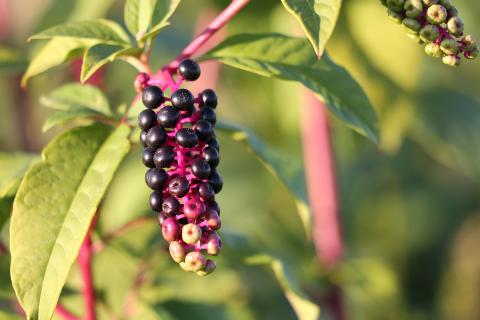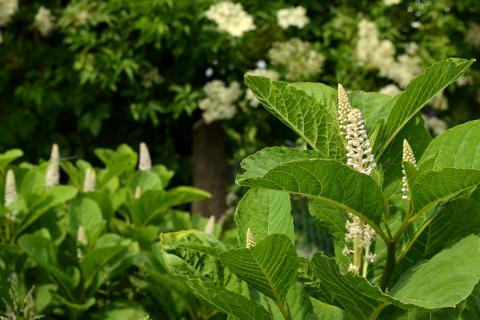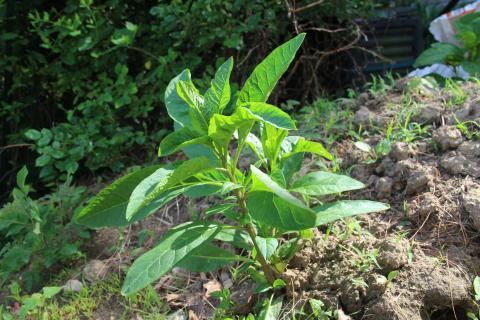Should I Remove Pokeweed From My Garden? It Depends.

Pokeweed (Phytolacca americana) is unmistakable. Strikingly beautiful, but also toxic to people and other mammals, it’s an impressive sight - just not one you want to see everywhere. Removing pokeweed is easier said than done, though, and before you decide whether to remove it, it's helpful to learn about the plant, including how to identify it and where it tends to thrive.
Identification
A native herbaceous perennial, pokeweed emerges each spring in a cluster of fresh green shoots. These quickly develop into a large plant up to 8 to 10 feet tall with simple leaves – smooth, hairless, bright green in color, and up to a foot long and 4 to 7 inches wide – arranged alternately on branching stems. By midsummer, white or green flowers emerge, growing in 8” racemes and curled at the end. Later in the season, as fruit development begins, the stems turn from green to a stunning reddish-purple. By the end of summer the plant is covered with showy and distinctive clusters of purple-black berries - often referred to as pokeberries - on brightly colored stems. The leaves give off an unpleasant odor when crushed. At the end of each season, this monstrous plant dies back, leaving nothing but an enormous taproot up to 4 inches wide and 12 inches deep below the soil line. There’s simply no plant like pokeweed.

The Pokeweed Conundrum
For many gardeners, pokeweed represents a conundrum. On the one hand, all parts of pokeweed are considered toxic, especially its root and seeds, both to eat and to touch. It’s likely to cause severe intestinal distress for anyone who consumes it – such as young children who might be drawn to its bright colors, or curious pets. If you do come in contact with pokeweed, consult your local Poison Center. Pokeweed should always be handled with caution, including wearing gloves.
On the other hand, pokeweed in a native plant that provides an important food source for songbirds. It has a long history of culinary, medicinal and decorative use. Its berries have been used as an ink and a dye, and young boiled shoots are consumed (after careful preparation) as an asparagus-like vegetable, a cooked green, and even pickled.
Pokeweed has several similarities to poison ivy. It’s a native plant that is toxic to touch, the berries are a valuable food source for songbirds, and it’s an aggressive colonizer. But one significant difference is that pokeweed is unmistakable and easily avoided, whereas poison ivy can hide in plain sight and is easily mistaken for other plants.
Growing Conditions
Pokeweed does indeed grow like a weed, in large part because songbirds disperse the seeds readily and because it grows and colonizes aggressively. Pokeweed is often found growing in disturbed sites such as in roadside drainage ditches but is also known to grow along the edges of fields, yards and gardens. It tends to thrive in moister yet well-draining soil, including damp thickets and open woods.

Photo: NY State IPM Program at Cornell University via Flickr
Management and Control
In parts of your property that are more unkept, you may want to leave pokeweed for wildlife. But anywhere kids and pets may encounter it, or where it's unwanted, manually remove the plants early in the season, before they flower and go to seed. Hand pulling is more effective on younger plants without large and established root systems. When removing pokeweed later in the season, ripe berries should be bagged and discarded. For this reason, it’s helpful to learn to identify pokeweed early in the season before it becomes more distinctive, but more difficult to remove, later in the year. For herbicide recommendations, contact UNH Extension or your state’s Cooperative Extension service.
Do you love learning about stuff like this?
SUBSCRIBE TO GRANITE STATE GARDENING
A monthly newsletter for New Hampshire gardeners, homesteaders and plant-lovers of all kinds, that includes seasonal suggested gardening tips, upcoming events and articles with proven solutions for your garden and landscape.
Got questions? The UNH Extension Infoline offers practical help finding answers for your home, yard, and garden questions. Call toll free at 1-877-398-4769, Monday to Friday, 9 a.m. to 2 p.m., or e-mail us at answers@unh.edu.
